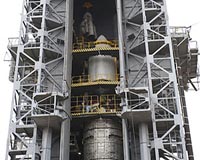 |
Paris, France (ESA) Nov 02, 2009 The Russian State Commission has given the go-ahead to fuel the Rockot launcher that will take ESA's SMOS and Proba-2 satellites into orbit. This formal authorisation confirms that launch can take place on 2 November at 02:50 CET (01:50 UT). The go-ahead to fuel follows the launch dress rehearsal, which took place in the Mission Control Centre near the Plesetsk launch site on 28 October. The rehearsal involved running a simulated launch countdown sequence in conjunction with operation centres at the French space agency CNES in Toulouse, France, and ESA's European Space Astronomy Centre (ESAC) in Villafranca, Spain, for SMOS and ESA's ground station in Redu, Belgium, for Proba-2. A formal review with the Russian State Commission was held, where representatives of the various organisations involved were asked to report on the status of their activities. In his statement to the State Commission, ESA's Project Manager for SMOS, Achim Hahne said, "I herewith can report that the SMOS and Proba-2 spacecrafts are fully tested, fuelled, and prepared for launch. I therefore ask the honourable gentlemen of the State Commission to authorise the fuelling of the launcher and conduct the final launch preparations. I would like to express my gratitude for the professional support we have experienced from all involved entities: the Russian Space Forces, Krunichev, and Eurockot." The State Commission's confirmation of readiness to fuel marks one of the last important milestones on the road to launch SMOS and Proba-2. Both satellites have been several years in the making and, with launch now confirmed, their missions to advance science and technology will soon begin. The SMOS mission, also known as 'ESA's water mission' will employ a new use of technology to measure the moisture in soil and salinity in the surface waters of the oceans. The data will improve our understanding of the water cycle and be important for weather and climate modelling, water resource management, agriculture and also contribute to the forecasting of hazardous events such as floods. ESA's Project Manager for Proba-2, Karsten Strauch, said, "Proba-2 is the second mission in ESA's In-Orbit Demonstration Programme, which is dedicated to demonstrating innovative technologies. Looking forward to its launch and operations phase, I want to express my thanks to all involved so far in this marvellous Proba project." Proba-2 is the second Project for Onboard Autonomy mission. As a technology demonstrator, it incorporates a total of 17 new technical developments and four scientific experiments, focused on solar and space weather observations. Both SMOS and Proba-2 are launching on the same Rockot launcher, which is a converted SS-19 intercontinental ballistic missile with a new Breeze-KM upper stage. SMOS will be injected into orbit 70 minutes after launch, with confirmation of separation coming from Hertebeesthoek in South Africa. The much smaller Proba-2 satellite sits below SMOS in the fairing, and is injected into orbit around 80 minutes after SMOS. Share This Article With Planet Earth
Related Links SMOS Proba-2 Launch Pad at Space-Travel.com
 Follow The Launch Of ESA's SMOS And Proba-2 Satellites
Follow The Launch Of ESA's SMOS And Proba-2 SatellitesParis, France (ESA) Oct 29, 2009 ESA's SMOS (Soil Moisture and Ocean Salinity) and Proba-2 (PRoject for OnBoard Autonomy) satellites are scheduled for launch on Monday 2 November at 02:50 CET on a Russian Rockot launcher from the Plesetsk cosmodrome in northern Russia. SMOS, ESA's water mission, is the first satellite designed both to map sea surface salinity and monitor soil moisture on a global scale, thus contributing ... read more |
|
| The content herein, unless otherwise known to be public domain, are Copyright 1995-2009 - SpaceDaily. AFP and UPI Wire Stories are copyright Agence France-Presse and United Press International. ESA Portal Reports are copyright European Space Agency. All NASA sourced material is public domain. Additional copyrights may apply in whole or part to other bona fide parties. Advertising does not imply endorsement,agreement or approval of any opinions, statements or information provided by SpaceDaily on any Web page published or hosted by SpaceDaily. Privacy Statement |